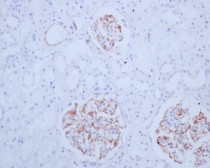ARG59138
anti-Mast Cell Tryptase antibody
anti-Mast Cell Tryptase antibody for IHC-Formalin-fixed paraffin-embedded sections,Western blot and Human
Overview
| Product Description | Rabbit Polyclonal antibody recognizes Mast Cell Tryptase |
|---|---|
| Tested Reactivity | Hu |
| Tested Application | IHC-P, WB |
| Host | Rabbit |
| Clonality | Polyclonal |
| Isotype | IgG |
| Target Name | Mast Cell Tryptase |
| Antigen Species | Human |
| Immunogen | Synthetic peptide derived from Human Mast Cell Tryptase. |
| Conjugation | Un-conjugated |
| Alternate Names | TPSB1; Tryptase I; Tryptase alpha-1; Tryptase alpha/beta-1; TPS1; TPS2; EC 3.4.21.59; Tryptase-1 |
Application Instructions
| Application Suggestion |
|
||||||
|---|---|---|---|---|---|---|---|
| Application Note | * The dilutions indicate recommended starting dilutions and the optimal dilutions or concentrations should be determined by the scientist. | ||||||
| Observed Size | ~ 30 kDa |
Properties
| Form | Liquid |
|---|---|
| Purification | Affinity purified. |
| Buffer | PBS (pH 7.4), 0.02% Sodium azide and 50% Glycerol. |
| Preservative | 0.02% Sodium azide |
| Stabilizer | 50% Glycerol |
| Storage Instruction | For continuous use, store undiluted antibody at 2-8°C for up to a week. For long-term storage, aliquot and store at -20°C. Storage in frost free freezers is not recommended. Avoid repeated freeze/thaw cycles. Suggest spin the vial prior to opening. The antibody solution should be gently mixed before use. |
| Note | For laboratory research only, not for drug, diagnostic or other use. |
Bioinformation
| Database Links | |
|---|---|
| Gene Symbol | TPSAB1 |
| Gene Full Name | tryptase alpha/beta 1 |
| Background | Tryptases comprise a family of trypsin-like serine proteases, the peptidase family S1. Tryptases are enzymatically active only as heparin-stabilized tetramers, and they are resistant to all known endogenous proteinase inhibitors. Several tryptase genes are clustered on chromosome 16p13.3. These genes are characterized by several distinct features. They have a highly conserved 3' UTR and contain tandem repeat sequences at the 5' flank and 3' UTR which are thought to play a role in regulation of the mRNA stability. These genes have an intron immediately upstream of the initiator Met codon, which separates the site of transcription initiation from protein coding sequence. This feature is characteristic of tryptases but is unusual in other genes. The alleles of this gene exhibit an unusual amount of sequence variation, such that the alleles were once thought to represent two separate genes, alpha and beta 1. Beta tryptases appear to be the main isoenzymes expressed in mast cells; whereas in basophils, alpha tryptases predominate. Tryptases have been implicated as mediators in the pathogenesis of asthma and other allergic and inflammatory disorders. [provided by RefSeq, Jul 2008] |
| Function | Tryptase is the major neutral protease present in mast cells and is secreted upon the coupled activation-degranulation response of this cell type. May play a role in innate immunity. Isoform 2 cleaves large substrates, such as fibronectin, more efficiently than isoform 1, but seems less efficient toward small substrates. [UniProt] |
| Cellular Localization | Secreted. Note=Released from the secretory granules upon mast cell activation. [UniProt] |
| Calculated MW | 31 kDa |
Images (2) Click the Picture to Zoom In
-
ARG59138 anti-Mast Cell Tryptase antibody IHC-P image
Immunohistochemistry: Paraffin-embedded Human kidney stained with ARG59138 anti-Mast Cell Tryptase antibody.
-
ARG59138 anti-Mast Cell Tryptase antibody WB image
Western blot: Human tonsil lysate stained with ARG59138 anti-Mast Cell Tryptase antibody.







